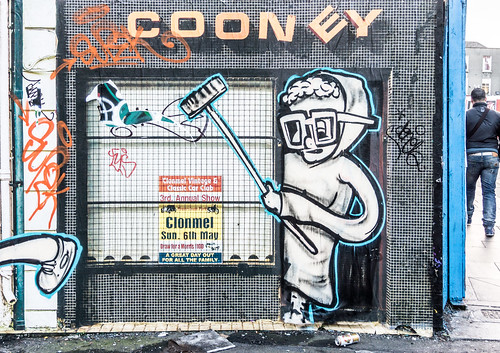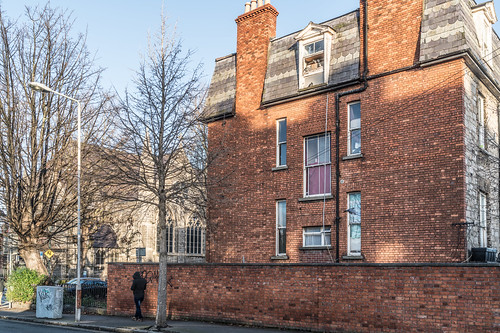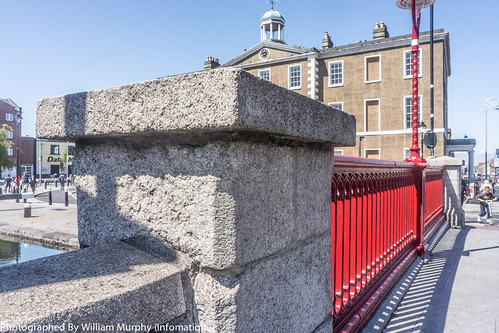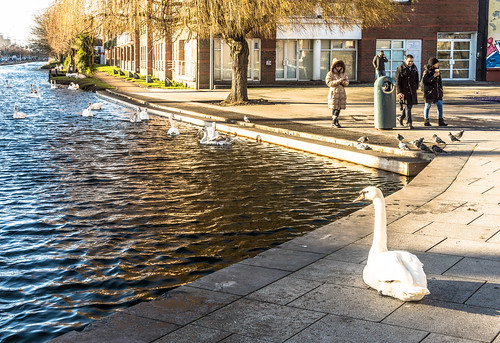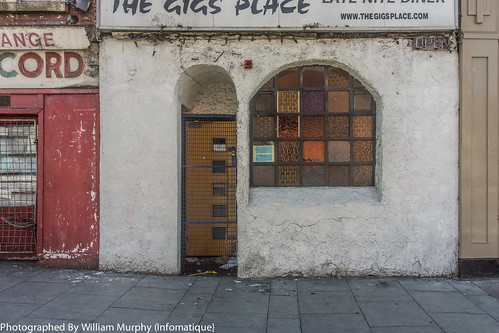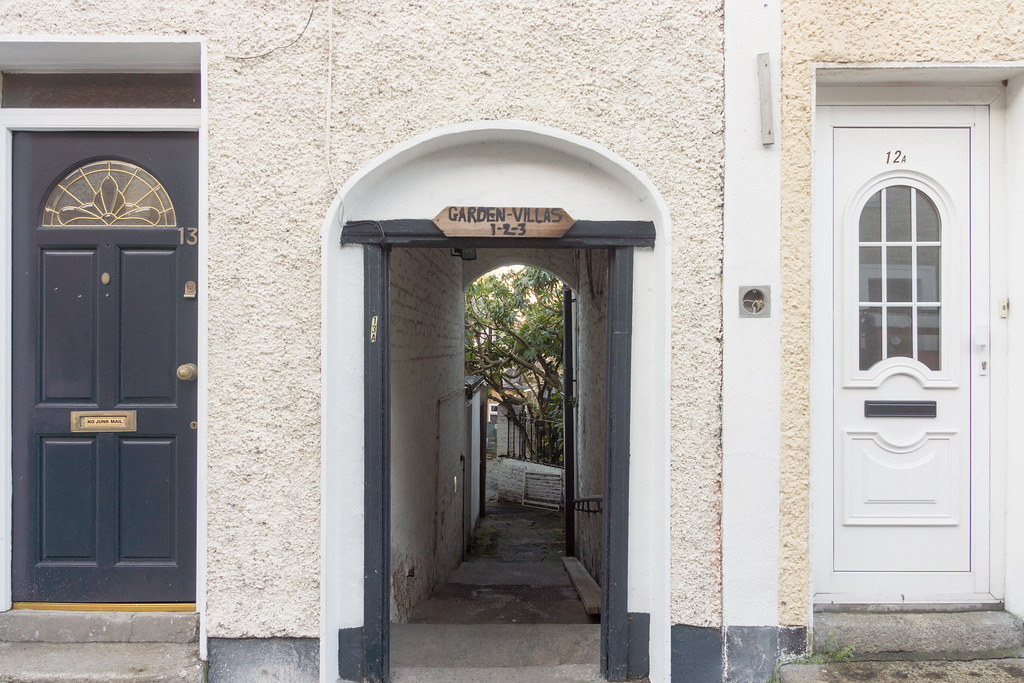THE PORTOBELLO AREA OF DUBLIN THE STREETS OF DUBLIN PROJECT
In Dublin, Portobello is an area stretching westwards from South Richmond Street as far as Upper Clanbrassil Street bordered on the north by the South Circular Road and on the south by the Grand Canal.
Portobello came into existence as a small suburb south of the city of Dublin in the 18th century, centred on Richmond St. During the following century it was completely developed, transforming an area of private estates and farmland into solid Victorian red-bricked living quarters for the middle classes (on the larger streets), and terraced housing bordering the canal for the working classes.
As a fast-expanding suburb during the 19th century Portobello attracted many upwardly-mobile families whose members went on to play important roles in politics, the arts and the sciences. Towards the end of the century came an influx of Jews, refugees from pogroms in Eastern Europe, which gave the name "Little Jerusalem" to the area.
It is in the postal district of Dublin 8. It is in the local government electoral area of Dublin South East Inner City and the Dáil Constituency of Dublin Bay South.
The name Portobello also describes the stretch of the Grand Canal leading from Robert Emmet Bridge (Clanbrassil Street) to the bridge from South Richmond Street to Rathmines. Although usually referred to as Portobello Bridge, the correct name is La Touche Bridge (named after William Digges La Touche (1747–1803), scion of a prominent Dublin business family and a director of the Grand Canal Company). Like the Portobello Road of London, Dublin's Portobello was named for the capture by Admiral Edward Vernon in 1739 of Portobelo, Colón on Panama's Caribbean Coast, during the conflict between the United Kingdom and Spain known as the War of Jenkins' Ear.
A century before the naming of the suburb, an eventful battle took place in the neighbourhood – the Battle of Rathmines. In the early years of the Irish Confederate Wars (1641–1649) incursions were made into the area as far as St. Kevin's church by bands of Confederate soldiers stationed in Wicklow. They made off with cattle, horses and the occasional wealthy merchant. After the Irish united with the Royalists against the Parliamentarians, an attempt was made to take Dublin. In the summer of 1649 the Duke of Ormonde, head of the forces of Royalists and Irish soldiers, approached Dublin, where the Parliamentarian army was holed up. For some unaccountable reason he took his army over to Finglas, where he spent a month, which allowed the Roundheads to reinforce and plan their attack. By the time Ormonde's main force moved around to the south of the city, the Roundheads were ready and fighting broke out. Ormonde's army was defeated, many of them killed, and the place where they fell (mainly between Rathmines and Ranelagh) was known for a long time as the Bloody Fields. The name of the Bleeding Horse pub in Camden Street reputedly originated at this time from a horse wandering from the scene of the battle to St. Kevin's Port (now Camden Street).
The Bleeding Horse pub is reputed to be the second oldest pub in Dublin, allegedly licensed in 1649. Writers such as James Joyce, Oliver St. John Gogarty and John Elwood were familiar with this tavern.
Portobello was part of the Manor of St. Sepulchre, one of the liberties of Dublin. The courthouse (still standing) and gaol for the use of the manor were located at the corner of Long Lane and New Bride Street.
The nearby Portobello Barracks (now Cathal Brugha Barracks) was constructed between 1810 and 1815, and has been in continual use since then.
In 1817, William Windham Sadlier successfully flew in a hot air balloon from Portobello Barracks to Holyhead in North Wales.
The 1837 Ordnance Survey map showed one building on the western side of Richmond St. (excluding property belonging to the Portobello Hotel), which corresponds to no. 34, which was the Caroline Records shop (closed in 2003).
In 1867, at the time of the Fenian Uprising, security was stepped up, and an innocent young resident of Bloomfield Avenue, walking his dog in the vicinity, was accused of breaking and entry, among other things. Admittedly, he had a hard time explaining away the gun and eighteen bullets he had in his pocket, but he was acquitted of any wrongdoing.
The barracks was the scene of a sensational murder on 27 December 1873, when the body of Gunner Colin Donaldson was found slumped across the bed of Anne Wyndford Marshall, in the apartment she shared with her husband. He had been poisoned with Hydrogen cyanide, which Mrs. Marshall had purchased in Rathmines a few days previously. The inquest on 8 January 1874 heard that Donaldson and Marshall had had disagreements on several occasions but ended up on good terms. Although the evidence was stacked against her, at her trial on 10 February the jury found Mrs. Marshall not guilty.
The barracks was adopted as General Michael Collins' Military Headquarters after the Irish War of Independence. The barracks hospital became Michael Collin's home when he set up his headquarters, it was from here that he set off to Cork, the day he was killed 22 August 1922.
The Dublin section of the Grand Canal was opened on 23 April 1796, while Portobello Harbour came into use in 1801. In 1812 Richmond Basin, Portobello, (later called the "City Basin"), located between Lennox Street and the canal, was opened as a water reservoir for the south side of the city.From 1860 investigations of the water quality coming from the Basin showed that it was not up to standard – in particular, levels of sulphuric acid were relatively high. Public representatives from Rathmines were unwilling to cough up the necessary money for a new water-works, but the will of the majority prevailed, and the new Vartry Reservoir was completed in 1863.
The hotel at the harbour was opened in 1807 (the architect was James Colbourne). In 1858 it was taken over by a Catholic order of nuns, who used it as an asylum (St. Mary's) for blind girls. A few years later they successfully appealed to the Guardians of the South Dublin Union for some finance (it cost £10 to keep a girl for a year), though the Irish Times in an editorial frowned upon this proselytising by "Romanists", while they lauded the efforts of the Protestant-run "Home for Orphans" at 7 South Richmond Street (which advertised frequently for "fresh souls to save" in the same newspaper). Ten years later the Asylum was sold to a Mr. Isaac Cole, who renovated it and returned it to its original function as a hotel, to accommodate 100 persons. It was popular among officers visiting the nearby Portobello Barracks (who would occasionally pop across South Richmond Street to the Grand Canal Tavern for a drink) and claimed it was the nearest hotel to the Royal Dublin Society grounds. However, it was slow in providing catering facilities – in 1871 a Rathmines businessman, in a letter to the Irish Times, lamented the absence of restaurants in the neighbourhood, and enjoined upon Mr. Cole to provide same, preferably a two-course meal for two shillings (the price to include beer and punch). In the 20th century the building became a nursing home.
Thomas Grubb (1800–1878), a notable optician, developed his first telescope in a small house between Portobello Bridge and Charlemont Bridge and erected a public observatory at No. 1 Upper Charlemont Street. He founded the Grubb Telescope Company. One of his earliest instruments – the telescope for Markree Observatory in County Sligo – was, for several years, the largest telescope in the world. They provided the telescopes for many observatories worldwide, including Melbourne, Vienna and Aldershot Observatory in 1891. The company was acquired in 1925 by Charles Algernon Parsons and renamed Sir Howard Grubb, Parsons and Co. Ltd.
Most of the area was developed in the latter half of the 19th century, the houses along the South Circular Road being built between 1850 and 1870, although the smaller houses off Lennox Street were built by the Dublin Artisans' Dwellings Company some time later, from 1885 (just in time, in fact, for the increasing number of Jews looking for houses in the area). This company also built houses on that part of Portobello Basin that was filled in 1883.
In 1868, a new street was opened to connect Harold's Cross with Lower Clanbrassil Street. The Lord Mayor, the Aldermen and Frederick Stokes, who had purchased the land and led the project, attended the opening. The street was to be called Kingsland Street, but in fact, that name was never used, and it became Upper Clanbrassil Street.
Part of Lennox Street, Victoria Street and Florence Street stretching from the canal to the South Circular Road were part of the Kingsland estate, which contained a park with a large pond and fountains, which opened as the Royal Portobello Gardens in 1839. The name survives in Kingsland Park Avenue. From 1858, Mssrs. Kirby and Webb leased the Portobello Gardens. Kirby was a pyrotechnician who lived in Sackville Street. During the summer months, gas and Chinese lamps illuminated the gardens, a band played outdoors, and the public were entertained by acrobats, dancers and "a highly trained troupe of performing dogs". And of course, fireworks.
In June 1850, the celebrated circus owner and performer, Pablo Fanque (a black man, later immortalised in The Beatles song Being for the Benefit of Mr. Kite! written entirely from his circus advertisement) announced that the sponsor of the events at the gardens "has the honor to inform the Nobility, Gentry, and the Public that he has entered into an arrangement with Mr. Pablo Fanque for three Grand Equestrian Day fetes, which will take place on the 10th, 12th, and 14th of June in an immense Pavilion which will be erected for the purpose." The same advertisements announced performances by R. W. Pelham, the American minstrel.
A huge crowd attraction at the gardens was the well-known tightrope walker Charles Blondin, who first performed at the gardens in August 1860. The previous year he had caused a sensation by crossing the Niagara Falls on a tightrope. In May, at the Crystal Palace, he had carried across a stove on the rope, then, still suspended on the wire, proceeded to cook omelettes, which he distributed to the audience below. On the evening of 23 August 1860, however, as the crowd packed the gardens, the tightrope broke, which led to the supporting scaffolding collapsing. Blondin was not injured, but two workers who were on the scaffolding fell to their deaths. Although they appeared as witnesses at an initial investigation, Blondin and his manager failed to appear at a further one (they were in the USA) and a warrant was issued for their arrest. However, things must have been ironed out, because August of the following year found the "far-famed unambulist performing his arduous and daring exploits" at the gardens, followed by "Madame Veroni's magic exploits".
Meanwhile, the proprietor of the gardens, Kirby, the pyrotechnician, was having problems with a pyromaniac, several attempts having been made on his property. In 1862 Kirby was the victim of arson, both the music hall in the gardens and his house in Sackville Street were burned down, resulting in high claims for compensation. Plans for developing the land at the gardens for housing started around this time. Frederick Stokes, J.P., an Englishman, the main developer of Rathmines and Portobello at the time, and Chairman of the Rathmines Township Commissioners, who drained it and let it out in building lots, purchased the land.
The original name of Victoria Street was Kingsland Park, which was developed from 1865 by Frederick Stokes. Some of the houses in this street remained empty for some time after they were built and were frequented by "ladies of the night", who catered to the nearby Portobello Barracks. As a result, the street acquired a bad reputation and respectable families moved out. Even after the ladies moved on, the bad reputation of the street remained, and thus the name was changed to Victoria Street. For a similar reason, Liverpool Road became Portobello Road and Bloomfield Place/Rosanna Place became Windor Terrace.
Across the road from Portobello Gardens was the Emorville Estate, which was sold and developed from around the mid-1860s by Joseph Kelly, proprietor of the City Saw Mills in Thomas Street. Today Emorville Avenue marks the spot. Before it was broken up Leinster Cricket Club (founded 1852) used it as their grounds, until they moved to their present grounds in Observatory Lane in 1865. Portobello had a cricket team of its own, but the location of its grounds has yet to be discovered. Included in this development was a small DMP police station at the corner of Emor Street and South Circular Road, which closed after the Free State came into being.
Several older streets in the neighbourhood (i.e., Richmond, Harrington, Lennox, Heytesbury and Camden) were named after British Viceroys. Newer streets were often named after the estates they were built on. Stamer Street, developed around 1880, was named after Sir William Stamer, Lord Mayor in 1809 and 1819 (a relative of his, Standish O'Grady, was killed in a duel in 1830 by Captain Smith from Portobello Barracks, who received twelve months for manslaughter). Foundlings left at Harrington Street church were usually named after one of the surrounding streets.
Between 1916 and 1921, Portobello and its eponymously named barracks were the scene of several incidents.
The main employer locally in the inter-war period and afterwards was Ever-Ready Batteries at Portobello Harbour. The factory is now closed and small businesses and attractive apartments occupy the space. The remainder of Portobello Harbour, located next to the Ever-Ready factory, was drained in 1948 and largely filled in.
In the 1960s, the Garda Club opened in Harrington Street (it is still used for social occasions) and Synge Street School obtained a new building fronting onto Heytesbury Street. The Bleeding Horse pub came under new management, introduced plastic fittings and changed its name to The Falcon.
Starting in the 1980s Kelly's Corner was re-developed. Old Camden Street and Charlotte Street disappeared and the ruined buildings there made way for the Camden Court Hotel. The north side of Harcourt road was developed, Stein's the opticians being the last to go in the first phase, and Gleeson's pub in the second.
In the 1990s, the east side of Charlemont Street and Grand Parade made way for offices, apartments and the Hilton Hotel. The Falcon was renovated and became again The Bleeding Horse. A few years later the Luas made its appearance on the old Harcourt Street-Bray railway line.
Nowadays community groups meet in St. Kevin's Hall, Bloomfield Avenue and Heytesbury Street. A monthly market is held behind the Bernard Shaw pub on Richmond Street.
The reclaimed land at Portobello Harbour is now a leisure area and often used for skateboarding. Next to it is the private Lamrin Business School, and just around the corner are various shops, pubs and restaurants, giving the locality a lively and vibrant air. South Richmond Street is part of the "Golden Mile" of music venues and bars leading into the city centre.
The Grand Canal received a much-needed restoration in the mid-1980s and again more recently. The canal is still thriving in a leisurely way and now serves as a picturesque amenity much frequented by the local population, not to mention the Corporation swans.
Portobello came into existence as a small suburb south of the city of Dublin in the 18th century, centred on Richmond St. During the following century it was completely developed, transforming an area of private estates and farmland into solid Victorian red-bricked living quarters for the middle classes (on the larger streets), and terraced housing bordering the canal for the working classes.
As a fast-expanding suburb during the 19th century Portobello attracted many upwardly-mobile families whose members went on to play important roles in politics, the arts and the sciences. Towards the end of the century came an influx of Jews, refugees from pogroms in Eastern Europe, which gave the name "Little Jerusalem" to the area.
It is in the postal district of Dublin 8. It is in the local government electoral area of Dublin South East Inner City and the Dáil Constituency of Dublin Bay South.
The name Portobello also describes the stretch of the Grand Canal leading from Robert Emmet Bridge (Clanbrassil Street) to the bridge from South Richmond Street to Rathmines. Although usually referred to as Portobello Bridge, the correct name is La Touche Bridge (named after William Digges La Touche (1747–1803), scion of a prominent Dublin business family and a director of the Grand Canal Company). Like the Portobello Road of London, Dublin's Portobello was named for the capture by Admiral Edward Vernon in 1739 of Portobelo, Colón on Panama's Caribbean Coast, during the conflict between the United Kingdom and Spain known as the War of Jenkins' Ear.
A century before the naming of the suburb, an eventful battle took place in the neighbourhood – the Battle of Rathmines. In the early years of the Irish Confederate Wars (1641–1649) incursions were made into the area as far as St. Kevin's church by bands of Confederate soldiers stationed in Wicklow. They made off with cattle, horses and the occasional wealthy merchant. After the Irish united with the Royalists against the Parliamentarians, an attempt was made to take Dublin. In the summer of 1649 the Duke of Ormonde, head of the forces of Royalists and Irish soldiers, approached Dublin, where the Parliamentarian army was holed up. For some unaccountable reason he took his army over to Finglas, where he spent a month, which allowed the Roundheads to reinforce and plan their attack. By the time Ormonde's main force moved around to the south of the city, the Roundheads were ready and fighting broke out. Ormonde's army was defeated, many of them killed, and the place where they fell (mainly between Rathmines and Ranelagh) was known for a long time as the Bloody Fields. The name of the Bleeding Horse pub in Camden Street reputedly originated at this time from a horse wandering from the scene of the battle to St. Kevin's Port (now Camden Street).
The Bleeding Horse pub is reputed to be the second oldest pub in Dublin, allegedly licensed in 1649. Writers such as James Joyce, Oliver St. John Gogarty and John Elwood were familiar with this tavern.
Portobello was part of the Manor of St. Sepulchre, one of the liberties of Dublin. The courthouse (still standing) and gaol for the use of the manor were located at the corner of Long Lane and New Bride Street.
The nearby Portobello Barracks (now Cathal Brugha Barracks) was constructed between 1810 and 1815, and has been in continual use since then.
In 1817, William Windham Sadlier successfully flew in a hot air balloon from Portobello Barracks to Holyhead in North Wales.
The 1837 Ordnance Survey map showed one building on the western side of Richmond St. (excluding property belonging to the Portobello Hotel), which corresponds to no. 34, which was the Caroline Records shop (closed in 2003).
In 1867, at the time of the Fenian Uprising, security was stepped up, and an innocent young resident of Bloomfield Avenue, walking his dog in the vicinity, was accused of breaking and entry, among other things. Admittedly, he had a hard time explaining away the gun and eighteen bullets he had in his pocket, but he was acquitted of any wrongdoing.
The barracks was the scene of a sensational murder on 27 December 1873, when the body of Gunner Colin Donaldson was found slumped across the bed of Anne Wyndford Marshall, in the apartment she shared with her husband. He had been poisoned with Hydrogen cyanide, which Mrs. Marshall had purchased in Rathmines a few days previously. The inquest on 8 January 1874 heard that Donaldson and Marshall had had disagreements on several occasions but ended up on good terms. Although the evidence was stacked against her, at her trial on 10 February the jury found Mrs. Marshall not guilty.
The barracks was adopted as General Michael Collins' Military Headquarters after the Irish War of Independence. The barracks hospital became Michael Collin's home when he set up his headquarters, it was from here that he set off to Cork, the day he was killed 22 August 1922.
The Dublin section of the Grand Canal was opened on 23 April 1796, while Portobello Harbour came into use in 1801. In 1812 Richmond Basin, Portobello, (later called the "City Basin"), located between Lennox Street and the canal, was opened as a water reservoir for the south side of the city.From 1860 investigations of the water quality coming from the Basin showed that it was not up to standard – in particular, levels of sulphuric acid were relatively high. Public representatives from Rathmines were unwilling to cough up the necessary money for a new water-works, but the will of the majority prevailed, and the new Vartry Reservoir was completed in 1863.
The hotel at the harbour was opened in 1807 (the architect was James Colbourne). In 1858 it was taken over by a Catholic order of nuns, who used it as an asylum (St. Mary's) for blind girls. A few years later they successfully appealed to the Guardians of the South Dublin Union for some finance (it cost £10 to keep a girl for a year), though the Irish Times in an editorial frowned upon this proselytising by "Romanists", while they lauded the efforts of the Protestant-run "Home for Orphans" at 7 South Richmond Street (which advertised frequently for "fresh souls to save" in the same newspaper). Ten years later the Asylum was sold to a Mr. Isaac Cole, who renovated it and returned it to its original function as a hotel, to accommodate 100 persons. It was popular among officers visiting the nearby Portobello Barracks (who would occasionally pop across South Richmond Street to the Grand Canal Tavern for a drink) and claimed it was the nearest hotel to the Royal Dublin Society grounds. However, it was slow in providing catering facilities – in 1871 a Rathmines businessman, in a letter to the Irish Times, lamented the absence of restaurants in the neighbourhood, and enjoined upon Mr. Cole to provide same, preferably a two-course meal for two shillings (the price to include beer and punch). In the 20th century the building became a nursing home.
Thomas Grubb (1800–1878), a notable optician, developed his first telescope in a small house between Portobello Bridge and Charlemont Bridge and erected a public observatory at No. 1 Upper Charlemont Street. He founded the Grubb Telescope Company. One of his earliest instruments – the telescope for Markree Observatory in County Sligo – was, for several years, the largest telescope in the world. They provided the telescopes for many observatories worldwide, including Melbourne, Vienna and Aldershot Observatory in 1891. The company was acquired in 1925 by Charles Algernon Parsons and renamed Sir Howard Grubb, Parsons and Co. Ltd.
Most of the area was developed in the latter half of the 19th century, the houses along the South Circular Road being built between 1850 and 1870, although the smaller houses off Lennox Street were built by the Dublin Artisans' Dwellings Company some time later, from 1885 (just in time, in fact, for the increasing number of Jews looking for houses in the area). This company also built houses on that part of Portobello Basin that was filled in 1883.
In 1868, a new street was opened to connect Harold's Cross with Lower Clanbrassil Street. The Lord Mayor, the Aldermen and Frederick Stokes, who had purchased the land and led the project, attended the opening. The street was to be called Kingsland Street, but in fact, that name was never used, and it became Upper Clanbrassil Street.
Part of Lennox Street, Victoria Street and Florence Street stretching from the canal to the South Circular Road were part of the Kingsland estate, which contained a park with a large pond and fountains, which opened as the Royal Portobello Gardens in 1839. The name survives in Kingsland Park Avenue. From 1858, Mssrs. Kirby and Webb leased the Portobello Gardens. Kirby was a pyrotechnician who lived in Sackville Street. During the summer months, gas and Chinese lamps illuminated the gardens, a band played outdoors, and the public were entertained by acrobats, dancers and "a highly trained troupe of performing dogs". And of course, fireworks.
In June 1850, the celebrated circus owner and performer, Pablo Fanque (a black man, later immortalised in The Beatles song Being for the Benefit of Mr. Kite! written entirely from his circus advertisement) announced that the sponsor of the events at the gardens "has the honor to inform the Nobility, Gentry, and the Public that he has entered into an arrangement with Mr. Pablo Fanque for three Grand Equestrian Day fetes, which will take place on the 10th, 12th, and 14th of June in an immense Pavilion which will be erected for the purpose." The same advertisements announced performances by R. W. Pelham, the American minstrel.
A huge crowd attraction at the gardens was the well-known tightrope walker Charles Blondin, who first performed at the gardens in August 1860. The previous year he had caused a sensation by crossing the Niagara Falls on a tightrope. In May, at the Crystal Palace, he had carried across a stove on the rope, then, still suspended on the wire, proceeded to cook omelettes, which he distributed to the audience below. On the evening of 23 August 1860, however, as the crowd packed the gardens, the tightrope broke, which led to the supporting scaffolding collapsing. Blondin was not injured, but two workers who were on the scaffolding fell to their deaths. Although they appeared as witnesses at an initial investigation, Blondin and his manager failed to appear at a further one (they were in the USA) and a warrant was issued for their arrest. However, things must have been ironed out, because August of the following year found the "far-famed unambulist performing his arduous and daring exploits" at the gardens, followed by "Madame Veroni's magic exploits".
Meanwhile, the proprietor of the gardens, Kirby, the pyrotechnician, was having problems with a pyromaniac, several attempts having been made on his property. In 1862 Kirby was the victim of arson, both the music hall in the gardens and his house in Sackville Street were burned down, resulting in high claims for compensation. Plans for developing the land at the gardens for housing started around this time. Frederick Stokes, J.P., an Englishman, the main developer of Rathmines and Portobello at the time, and Chairman of the Rathmines Township Commissioners, who drained it and let it out in building lots, purchased the land.
The original name of Victoria Street was Kingsland Park, which was developed from 1865 by Frederick Stokes. Some of the houses in this street remained empty for some time after they were built and were frequented by "ladies of the night", who catered to the nearby Portobello Barracks. As a result, the street acquired a bad reputation and respectable families moved out. Even after the ladies moved on, the bad reputation of the street remained, and thus the name was changed to Victoria Street. For a similar reason, Liverpool Road became Portobello Road and Bloomfield Place/Rosanna Place became Windor Terrace.
Across the road from Portobello Gardens was the Emorville Estate, which was sold and developed from around the mid-1860s by Joseph Kelly, proprietor of the City Saw Mills in Thomas Street. Today Emorville Avenue marks the spot. Before it was broken up Leinster Cricket Club (founded 1852) used it as their grounds, until they moved to their present grounds in Observatory Lane in 1865. Portobello had a cricket team of its own, but the location of its grounds has yet to be discovered. Included in this development was a small DMP police station at the corner of Emor Street and South Circular Road, which closed after the Free State came into being.
Several older streets in the neighbourhood (i.e., Richmond, Harrington, Lennox, Heytesbury and Camden) were named after British Viceroys. Newer streets were often named after the estates they were built on. Stamer Street, developed around 1880, was named after Sir William Stamer, Lord Mayor in 1809 and 1819 (a relative of his, Standish O'Grady, was killed in a duel in 1830 by Captain Smith from Portobello Barracks, who received twelve months for manslaughter). Foundlings left at Harrington Street church were usually named after one of the surrounding streets.
Between 1916 and 1921, Portobello and its eponymously named barracks were the scene of several incidents.
The main employer locally in the inter-war period and afterwards was Ever-Ready Batteries at Portobello Harbour. The factory is now closed and small businesses and attractive apartments occupy the space. The remainder of Portobello Harbour, located next to the Ever-Ready factory, was drained in 1948 and largely filled in.
In the 1960s, the Garda Club opened in Harrington Street (it is still used for social occasions) and Synge Street School obtained a new building fronting onto Heytesbury Street. The Bleeding Horse pub came under new management, introduced plastic fittings and changed its name to The Falcon.
Starting in the 1980s Kelly's Corner was re-developed. Old Camden Street and Charlotte Street disappeared and the ruined buildings there made way for the Camden Court Hotel. The north side of Harcourt road was developed, Stein's the opticians being the last to go in the first phase, and Gleeson's pub in the second.
In the 1990s, the east side of Charlemont Street and Grand Parade made way for offices, apartments and the Hilton Hotel. The Falcon was renovated and became again The Bleeding Horse. A few years later the Luas made its appearance on the old Harcourt Street-Bray railway line.
Nowadays community groups meet in St. Kevin's Hall, Bloomfield Avenue and Heytesbury Street. A monthly market is held behind the Bernard Shaw pub on Richmond Street.
The reclaimed land at Portobello Harbour is now a leisure area and often used for skateboarding. Next to it is the private Lamrin Business School, and just around the corner are various shops, pubs and restaurants, giving the locality a lively and vibrant air. South Richmond Street is part of the "Golden Mile" of music venues and bars leading into the city centre.
The Grand Canal received a much-needed restoration in the mid-1980s and again more recently. The canal is still thriving in a leisurely way and now serves as a picturesque amenity much frequented by the local population, not to mention the Corporation swans.
You will find links to buy products from Amazon, Google and other partners. If you click on these links, you’ll find that the URL includes a small extra piece of text which identifies that the click came from my websites. This text is an affiliate code, and it means that I get a small percentage of the money you spend if you choose to buy that product, or, in some cases, other products from the site soon after. These affiliate links help pay the costs of producing my websites and ensure that the content is free to you.
COPYRIGHT INFORMATION BELOW APPLIES ONLY TO PHOTOGRAPHS

This work by William Murphy aka Infomatique is licensed under a Creative Commons Attribution-NonCommercial-ShareAlike 4.0 International License.
Permissions beyond the scope of this license may be available at https://excellentstreetimages.com/in-the-year-twentytwenty/copyright/.
